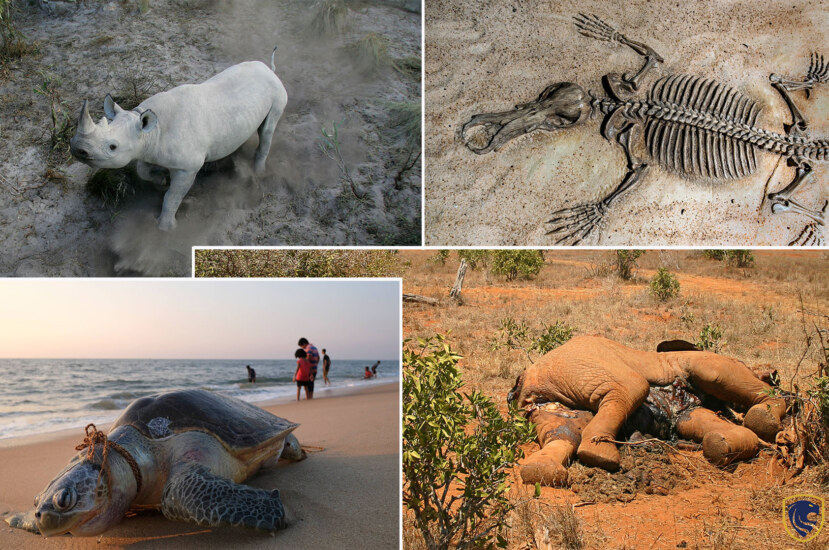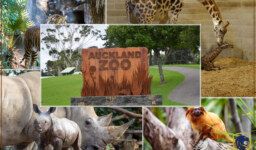What is extinction?
Extinction can be simply defined as the total disappearance of a species from the Earth. It occurs when environmental factors or evolutionary issues affect a species to die out from its environment forever. The disappearance of species from Earth or extinction is still occurring, and rates and species have varied over time due to the above-mentioned factors.
A quarter of mammals currently existing in the world are at risk of extinction, according to the estimates of the IUCN Red List. To some extent, extinction is natural. Every year, species face extinction and historical rates of extinction have been slow. But gradually, the rate of extinction caused due to artificial factors had raised in number.

What is extinction?; Humans are causing the extinction of numerous animal species worldwide.
Types of extinction
Extinction can be categorized into two main types. The first one is mass extinction. Mass extinction can be defined as an unnatural event. This type of extinction is not so common and do not occur in short, period Majority of the Past mass extinctions was caused by extreme temperature changes, sudden fluctuations in sea levels (rising or falling ), and destructive events. (volcano erupting or an asteroid hitting Earth). There were five mass extinctions which were recorded in history.
Ordovician-Silurian Extinction
This extinction has occurred 440 million years ago. A series of extinctions took place during the Ordovician and Silurian periods. As the most adverse effect, 85 percent of all animal species and nearly all the marine organisms (in this era, all the existing animals lived in the oceans) on Earth had been wiped out. Ordovician-Silurian Extinction was the second-largest mass extinction in history.

Ordovician-Silurian Extinction
Devonian Extinction
365 million years ago, the extinction called Devonian has taken place. The cataclysmic extinction event marked the end of the Devonian period, threatening to warm water marine creatures. Between the two extinction pulses, nearly 70-80 percent of marine invertebrate species died out.

Devonian Extinction; Humans are causing the extinction of numerous animal species worldwide.
Permian-Triassic Extinction
Permian-Triassic Extinction has taken place, 250 million years ago. 90 percent of species that existed on the earth had been eliminated by this extinction. Terrestrial species and marine species were included in it. Moreover, this extinction results wipe out more than half of the taxonomies that existed in the Permian-Triassic era.

Permian-Triassic Extinction
Triassic-Jurassic Extinction
Triassic-Jurassic Extinction occurred 210 million years ago. The acidification of the oceans and global warming is occurred by the sudden increase in the ratio of co2 in the atmosphere. 76 percent of marine and terrestrial species on Earth were wiped out. During the Triassic extinction, living beings who existed on Erath faced too many dangers as extreme heat, heavy storms, and droughts. Due to these climatic
changes, the atmosphere was cool and dry but after the Pangaea split apart the climate was hot and dry. During this extinction, most of the marine invertebrates were able to survive while some suffered losses, especially shelled cephalopods, corals, sponges, and Brachiopods that live in the oceans, and casualtiescorals, phytosaurs, a group of crocodile-like animals that lived on land.

Triassic-Jurassic Extinction; Humans are causing the extinction of numerous animal species worldwide.
Cretaceous-tertiary Extinction
Cretaceous-tertiary Extinction occurred 65 million years ago and is best known for killing off the dinosaurs and extinct them forever. In the end-Cretaceous mass extinction of creatures like marine mollusks, gliding reptiles, and swimming reptiles and some of the plants and other animals died out completely from the Earth.

Cretaceous-tertiary Extinction
Background extinction
This form of extinction is the next type of extinction which is a natural process. Background extinction rate refers to the number of species that are expected to go extinct based on non-human factors over a particular period. Also, the background extinction rate is regularly measured over a particular period and a specific classification is done at the end. The main factor that causes background extinction is habitat loss, which most frequently occurs due to the increasing human population.
As a result of extinctions, animals and plants that cannot rescue under inappropriate environmental conditions, become fully extinct or endangered. Moreover, according to the impact that occurred animals have been categorized into conservation groups.

Background extinction; Humans are causing the extinction of numerous animal species worldwide.
Groups of Extinction
Extinct – (EX)
Extinct in the Wild – (EW)
Group of Threatened Critically Endangered(CR) Endangered(EN) Vulnerable (VU)
Group of Lower Risk
Near Threatened( NT) Conservation Dependent ( CN ) Least Concern ( LC )
Other Categories Data Deficient ( DD) Not Evaluated (NE)
Extinct Species

Extinct Species
When environmental or evolutionary issues distract the survival of a species, it causes that particular species to die out. A species no longer exists anywhere in the world, that particular species is said to be extinct. Also, when members of a species cannot obtain food, water, shelter, or space necessary to survive, they naturally wipe out from the environment with the lapse of time. The disappearance of species from the Earth is still occurring. Further, the rates of extinction have varied over time. As IUCN Red List estimates, a quarter of mammals are currently facing the threat of extinction.
According to the estimates, since 1500, 902 species have gone extinct. This includes 85 species of mammals, 159 species of birds, 35 species of amphibians, and 80 fish species. West African Black Rhinoceros, Baiji White Dolphin, Pyrenean Ibex, Passenger Pigeon, Tasmanian Tiger, Stellers Sea Cow, Dodo, and Wooly Mammoth are some examples of extinct animal species and Comanche Peak prairie clover, puzzle sunflower, Texas poppy mallow and Hinckley oak are some examples for plant species that lost forever.
Endangered Species

Endangered Species; Humans are causing the extinction of numerous animal species worldwide.
A species that is subjected to threatened by extinction is called endangered species. Species become endangered due to two main reasons. One is the loss of habitat. When the species is not able to find proper environmental conditions that suit survival, feeding, and reproduction, the decrease in the rate happens naturally. Loss of habitat is natural and can occur without any interference from man. As an example, dinosaurs lost their habitats about 65 million years ago and it became a prominent cause of their extinction. The second reason that affects endangering is the loss of genetic variation. When the rate of existence goes down, the ability for genetic variation also becomes low. Cheetah, Red tuna Tiger, Asian elephant, Mountain gorilla, Vaquita porpoise, Javan rhinoceros, and Irrawaddy river dolphin are some examples of endangered species.

Ways extinction happen
Significantly, five mass extinctions had taken place on Earth. Their Extinction can be a natural occurrence caused by,
- volcanic outbreaks
- methane outbreaks
- asteroids and other extraterrestrial crashes
- ecological intercourses (competition, disease, or predation)
- sea level falls
- anoxic events
- global warming, global cooling,
- diseases
Causes of Present-Day Extinctions
The biggest cause of extinction in present days is the loss of habitat which causes as a result by extreme.

Causes of Present-Day Extinctions; Humans are causing the extinction of numerous animal species worldwide.
deforestation. Activities that man interferes with, such as agriculture, forestry, mining, and extreme urbanization have disturbed or engulfed the land area, where animal and plant species used to exist. Moreover, competition, the introduction of invasive species, and over-exploitation. Further, genetic frailness that can be detected in a species such as insufficient or frailness in reproduction, genetic inbreeding, and, a decrease in population in a number had caused to decrease in the number of species that could be seen in an ecosystem.
Extinction is a natural and essential part of evolution, and it occurs periodically over time. According to the estimates of scientists,10% of species are lost every million years, 30% every 10 million years, and 65% every 100 million years. This extinction crisis may cause to make the whole world grave because when a species is wiped out from the world and another species comes to fill the gap, it could cause adversely for the balance of the ecosystem, especially the food chain. Therefore, existing species are a sign for the whole world including mankind.
Remedies for the issues

captivity breeding or captive propagation
Many suggestions have been made worldwide regarding the protection of the environment and reducing the rate of extinction. Most of the species of animals that have faces endanger are bred under captive breeding programs. For instance, process of maintaining plants or animals under controlled environments, such as wildlife reserves, zoos, botanic gardens, and other conservation facilities is known as captivity breeding or captive propagation Arabian oryx, Vancouver Island marmot, black-footed ferrets, and California condors are some instances of animals that breed in captivity. In addition, the Preservation of genetic materials, preserving species in aquariums zoos, and botanic gardens to let people see the beauty of the biodiversity, prohibiting harming animals. Also, it has become an essential requirement to create rules and regulations to protect endangered species from extinction.
National Wildlife Refuges
Further, those who are interested in providing their contribution to save endangered species can support National Wildlife Refuges. It provides shelter for nearly 513 endangered and threatened species. Also, you can fund the Endangered Species Act to strengthen the fund reserved for welfare programs of animals.

National Wildlife Refuges; Humans are causing the extinction of numerous animal species worldwide.
Most importantly, you can share what you feel about facing animals endangered and different unfortunate situations as a result of mankind. Share your thoughts on social media with the whole world to make others aware of the unseen disaster and educate them to be ethical tourists or an admirer of nature. Moreover, reduce using polythene and plastics and recycle your garbage wisely. Be an intelligent shopper, buy and sell environmentally friendly products, reduce your consumption of meat, and lower the carbon emissions to the atmosphere as much as you can. Also, plant a tree and prevent it from destroying the natural habitats of other living beings and help conserve water. Try at least one, and contribute to the universal attempt to save and conserve wildlife, animals, and plants for a sustainable future of the Earth.




